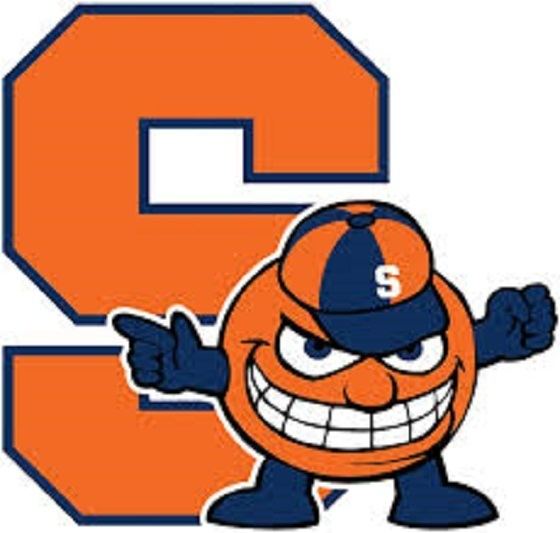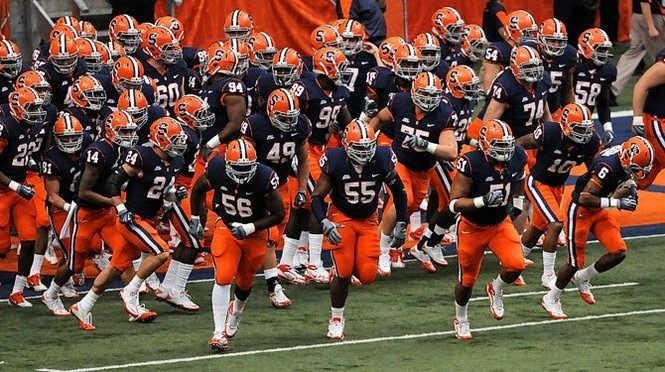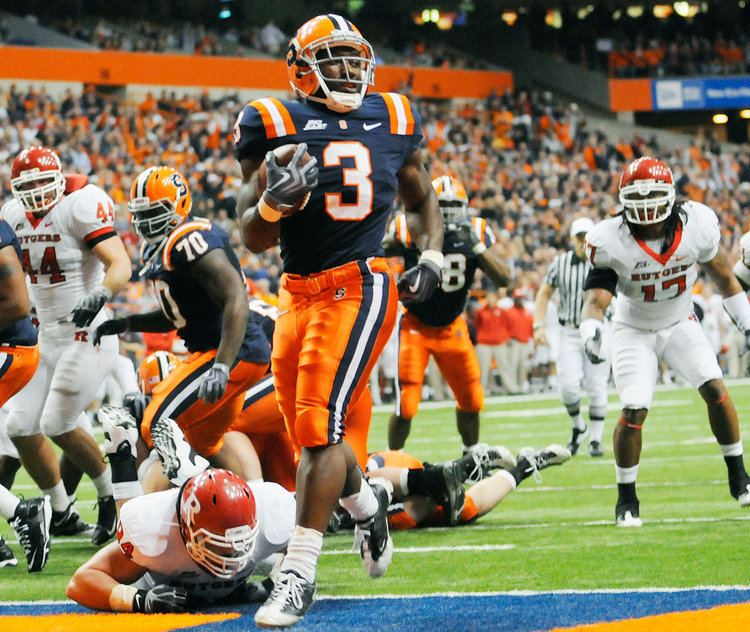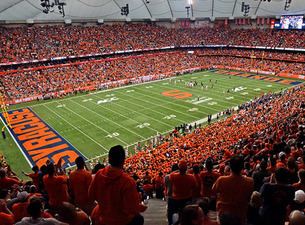First season 1889 Year built 1980 Field surface FieldTurf Head coach Dino Babers Arena/Stadium Carrier Dome Location Syracuse, New York | Athletic director John Wildhack Seating capacity 49,262 All-time record 697–503–49 (.578) Bowl record 15–9–1 (.620) Conference Atlantic Coast Conference Division Division I (NCAA) | |
 | ||
Rivals Pittsburgh Panthers football Profiles | ||
The Syracuse Orange football program is a college football team that represents Syracuse University. The team is a member of the Atlantic Coast Conference, which is a National Collegiate Athletic Association (NCAA) Division I conference that is part of the Football Bowl Subdivision. The program has one national championship, which was earned for play in the 1959 season. The Orange are coached by Dino Babers, who was hired on December 5, 2015 to succeed Scott Shafer. Home games are played at the Carrier Dome, located on the school's campus in Syracuse.
Contents
- Early History 1889 1948
- Ben Schwartzwalder era 1949 1973
- Frank Maloney era 1974 1980
- Dick MacPherson era 1981 1990
- Paul Pasqualoni era 1991 2004
- Greg Robinson era 2005 2008
- Doug Marrone era 2009 2012
- Scott Shafer era 2013 2015
- Dino Babers era 2016 present
- Boston College Eagles
- Penn State Nittany Lions
- Pittsburgh Panthers
- Rutgers Scarlet Knights
- West Virginia Mountaineers
- Retired numbers
- Syracuse football athletes in the Pro Football Hall of Fame
- Carrier Dome
- Manley Field House
- Future non conference opponents
- References

Early History (1889-1948)

Syracuse played its first football game on November 23, 1889, and achieved its first success in the 1890s and 1900s. With the construction of "state-of-the-art" Archbold Stadium in 1907, Syracuse rose to national prominence under College Football Hall of Fame coach Frank "Buck" O'Neill. The 1915 squad garnered a Rose Bowl invitation that the school declined, having already played on the West Coast that season.

The 1920s saw continued success with teams featuring star end Vic Hanson, one of only two individuals who are members (Amos Alonzo Stagg being the other) of both the Basketball Hall of Fame and the College Football Hall of Fame, and who later coached the team. For 70 years, from 1891 to 1961, Colgate University was the school's biggest rival, with Colgate holding the edge, 31–26–5.
From 1937-1945, Ossie Solem served as Syracuse's head coach, compiling a 30–27–6 record.
Ben Schwartzwalder era (1949-1973)

The late 1930s and 1940s saw a decline in fortunes that began to reverse when Ben Schwartzwalder took over as coach in 1949. Syracuse made its first bowl appearance in the 1953 Orange Bowl, followed by appearances in the 1957 Cotton Bowl and the 1959 Orange Bowl. The 1957 Cotton Bowl Classic team featured Hall of Fame running back Jim Brown.
In 1959, Syracuse earned its first National Championship following an undefeated season and Cotton Bowl Classic victory over Texas. The team featured sophomore running back Ernie Davis, who went on to become the first African American to win the Heisman Trophy in 1961, and All-America tackle Ron Luciano, who eventually become a prominent Major League Baseball umpire. Davis was slated to play for the Cleveland Browns in the same backfield as Jim Brown, but died of leukemia before being able to play professionally. Syracuse remained competitive through the 1960s with a series of All American running backs, including Floyd Little and Larry Csonka.
Schwartzwalder retired as Syracuse's head coach following the 1973 season, which was Syracuse's third consecutive losing season. Schwartzwalder left Syracuse with a 153–91–3 record.
Frank Maloney era (1974-1980)
Michigan assistant coach Frank Maloney was hired as Schwartzwalder's replacement. Maloney's tenure at Syracuse was marked by inconsistency. The fan base turned on him as the Orange failed to achieve the national status they had enjoyed under Schwartzwalder. Maloney's program was also limited by archaic facilities. Archbold Stadium, Syracuse's home field since 1907, was in need of replacement. Nonetheless, Maloney did recruit a number of future NFL stars such as Joe Morris and Pro Football Hall of Fame member Art Monk.
Maloney was the subject of criticism, not only from the fans and alumni, but also from the 1959 national championship team, members of which started a campaign calling for his ouster. Ironically enough, this call from program alumni came during the 1979 season, Maloney's best at Syracuse, when the Orangemen qualified for the Independence Bowl, beating McNeese State. After coaching the Orangemen for seven seasons and presiding over the opening of a new stadium, the Carrier Dome, in 1980, Maloney resigned.
Dick MacPherson era (1981-1990)
Dick MacPherson was hired as the head coach in 1981 and after several mediocre seasons, fans wanted MacPherson fired, coining the phrase, "Sack Mac."
However, the fans' opinion of Coach MacPherson changed when the program returned suddenly to national prominence in 1987 with an undefeated 11–0 regular season record. The team featured Maxwell Award winning quarterback Don McPherson and fullback Daryl Johnston. The team missed an opportunity to play for the NCAA Division I-A national football championship, because both Oklahoma and the Miami also finished undefeated that year and finished higher in the polls. Instead, the team faced Southeastern Conference champion Auburn University in the Sugar Bowl. The game ended in a tie when Auburn kicked a late field goal rather than trying for a game winning touchdown.
MacPherson left Syracuse after the 1990 season to accept the position of head coach for the NFL's New England Patriots.
Paul Pasqualoni era (1991-2004)
Syracuse continued to experience success under MacPherson's successor Paul Pasqualoni, previously the team's linebackers coach, appearing in 11 bowl games (including 3 major bowls) and winning 9. The team also captured or shared 3 Big East football championships during this period.
Prominent players of the period included Donovan McNabb, Marvin Harrison, Dwight Freeney, Keith Bulluck, Rob Moore, Donovin Darius, Qadry Ismail, Kevin Johnson, Rob Konrad, Tebucky Jones and Marvin Graves.
Rivalries shifted in the early 1990s as Penn State ended its series with Syracuse and joined the Big Ten. Syracuse, meanwhile, joined the newly formed Big East football conference with traditional rivals University of Pittsburgh, West Virginia University and national power Miami. In 2004, Miami and Virginia Tech left the Big East to join the Atlantic Coast Conference, followed by Boston College in 2005, threatening the stature of the Big East. Syracuse was originally invited to leave the Big East and join the ACC, but under pressure from the Governor of Virginia, the ACC decided to invite Virginia Tech to join the conference instead. Thus, Syracuse remained in the Big East.
Syracuse's streak of winning seasons ended in 2002 when they went 4–8. This was followed by consecutive 6–6 seasons. Although they won a share of the Big East title in 2004 and competed in the Champs Sports Bowl, the teams from 2002–2004 were considered mediocre by Syracuse standards. This prompted brand new athletic director Dr. Daryl Gross to fire Pasqualoni after 14 years at the helm.
Greg Robinson era (2005-2008)
In 2005 the University hired Greg Robinson, defensive coordinator for Texas, as head coach. Robinson installed a new West Coast offense scheme, replacing the option run style of offense previously run by Pasqualoni, as well as new defensive schemes.
The 2005 season started on a high note as Syracuse nearly upset eventual Big East and Sugar Bowl champion West Virginia, forcing 5 turnovers in the 15–7 loss. They followed it up with a 31–0 thrashing of Buffalo and another near upset win, this time to #25 Virginia where they lost 27–24 on a last second field goal. The squad lost its final 8 games of the season. Syracuse finished the year 1–10, the worst season in school history and won only ten games with Robinson running the program.
Robinson's Orange improved to 4–8 in 2006 but fell to 2–10 in 2007. The 2007 season included a road upset of #18 Louisville.
In 2008 the Orange continued to struggle and fired Robinson, following a 3–9 season where the high point was a 24–23 upset of Notre Dame; the game that signified the period the best was the 55–13 loss to Penn State.
Doug Marrone era (2009-2012)
It was announced on December 12, 2008 that Doug Marrone, a former Orange player and offensive coordinator for the NFL's New Orleans Saints, had been hired to replace Robinson as head coach. Marrone was the first Syracuse alumnus to serve as head football coach since Reaves H. Baysinger in 1948. Reportedly, alumni such as Tim Green and Floyd Little wanted Marrone from the moment the previous coach Greg Robinson was fired, and when interviewed by Green, it was learned that Marrone had kept a folder of current high school players in the Syracuse area to get a head start in recruiting.
Improvement throughout the program was noticed immediately as the Orange, despite only a marginal improvement in their win-loss record, going 4–8 under Marrone for his first year, played many much more closely, including a 28–7 loss at #7 Penn State.
In 2010, the Orange finished the regular season with a winning record for the first time since the 2001 season at 7–5, including road wins against #19 West Virginia and 2-time defending conference champions Cincinnati. The team earned its first bowl bid since 2004 and along with 2nd ranked Oregon and 10th ranked Boise State, the 5 road wins were the best in 2010 of all FBS teams. December 30, 2010, Syracuse defeated Kansas State in the inaugural Pinstripe Bowl at Yankee Stadium. The game was televised live on ESPN. Two years later, the Orange defeated West Virginia in the 2012 Pinstripe Bowl.
On January 7, 2013, Marrone left Syracuse, accepting the head coaching position of the NFL's Buffalo Bills.
Scott Shafer era (2013-2015)
The day after Marrone's departure, Syracuse promoted defensive coordinator Scott Shafer to head coach. Coach Shafer's first season was marked by inconsistency from the team.
In his first game at the helm, Coach Shafer nearly guided the team to an upset of Penn State, with the Orange losing 23–17. The Orange got their first win under Shafer in a 54–0 rout of Wagner, and followed it up with another blowout win, beating Tulane 52–17. However, the season also produced crushing losses, including a 49–14 defeat at home to fourth-ranked Clemson, and road losses to unranked Georgia Tech 56–0, and eventual national champions Florida State by a score of 59–3. Syracuse faced off against Boston College in the season finale. The Orange, needing a victory to become bowl eligible, were down 31–27 with 2:08 remaining. Quarterback Terrell Hunt orchestrated a 75-yard, game winning drive, that was capped off with a 25-yard touchdown pass to Tight End Josh Parris with six seconds remaining. With the victory, the Orange became bowl eligible for the third time in four years. Syracuse capped off the season with a 21–17 victory over Minnesota in the 2013 Texas Bowl to finish the year 7–6. 2013 was also the first season for the Orange in the ACC.
The 2014 season brought about a noticeable drop in quality despite the Orange starting the season 2–0. The season opener was a double overtime, 27–26 victory over FCS power Villanova, that was marked by a Syracuse extra point that was called good, however, replays later showed that it was wide-left, but kept Syracuse in the game anyway. Following a 40–3 blowout win at Central Michigan, Syracuse lost nine of its last ten games to finish the season a disappointing 3–9.
In 2015, fans and media noticed a significant up-tick in the teams performance after they started the season 3–0, and played tough with eighth-ranked LSU at home, losing 34–24, in their fourth game of the season. Although the Orange lost eight of their last nine games, they played closely with multiple ranked teams. In addition to the game with LSU, those games included home losses to #25 Pittsburgh, and top ranked Clemson, by scores of 23–20, and 37–27, respectively. They also lost a game on the road to ACC counterpart, Virginia, in triple overtime. Despite the improvement in performance, the team went 4–8, and on November 23, 2015, it was announced that Shafer would be fired after the last game of the 2015 campaign.
Dino Babers era (2016-present)
After an extensive coaching search, Syracuse announced the hiring of Bowling Green head coach Dino Babers as the new Orange head football coach. Babers is the first African-American head coach in school history. Babers brought with him an exciting, up-tempo offense he employed both as a head coach and as an assistant coach.
In Babers first season in charge, Syracuse started the year at 4–4, with the highlight of the first eight games being a 31–17 upset of No. 17 Virginia Tech at home. Syracuse kept the momentum from the upset going and beat rival Boston College on the road, 28–20. However, they were blown out 54–0 in their next game by No. 3 Clemson. In the final game of the season, Syracuse lost to ACC rival Pittsburgh by a score of 76–61. The game was the highest scoring in FBS history with a combined score of 137. Syracuse finished 4–8 for the second consecutive year.
Boston College Eagles
The two schools first met on October 18, 1924, a 10–0 win for the Syracuse Orange. The Eagles and the Orange began playing an annual game in 1961. To date, Boston College and Syracuse have played each other 46 times. Aside from Holy Cross, no team has played Boston College more than Syracuse. In 2004, the Eagles' last year in the Big East, the Orange pulled off a surprising upset that kept the Eagles from going to their first BCS game. BC's departure from the Big East put the future of the rivalry in doubt. Syracuse's admission into the ACC in 2013 resurrected the rivalry, with the two teams playing each another annually as members of the ACC's Atlantic Division.
Syracuse leads the series 30–19.
Penn State Nittany Lions
Syracuse and Penn State have played 71 times. However, conference realignment and scheduling disagreements have dampened the intensity of the rivalry between the teams. During the 1950s and 1960s the rivalry enjoyed a competitive and often controversial string of contests. Syracuse football was led by legendary coach Ben Schwartzwalder, and Penn State by Rip Engle from 1950-1966 and Joe Paterno from 1967-2011. From 1950 to 1970, Syracuse won 11 to Penn State's 10 games.
As Syracuse football floundered in the 1970s, Paterno's Penn State teams would go on to win 16 straight in the series from 1971 to 1986. Penn State fans and players increasingly turned their attention to the Penn State–Pittsburgh football rivalry.
In 1987, Dick MacPherson coached Syracuse to a 48–21 victory over the Nittany Lions in the Dome. Syracuse won again the following year at Penn State but lost the final two games before the suspension of the series in 1991. After an almost twenty-year break in the series, the two programs played in Syracuse's Carrier Dome on September 13, 2008, with the Nittany Lions prevailing 55–13 over the Orange.
Penn State leads the all-time series 43–23–5.
Pittsburgh Panthers
The football game between Syracuse and Pittsburgh has been played 71 times. The rivalry dates back to 1916 and has been played yearly since 1955. It is the second most played football rivalry for Syracuse and is tied for the third most played football rivalry for Pittsburgh. Pittsburgh leads the series 38–31–3. The two continue to play annually in the ACC, as they have been designated as crossover rivals, with Syracuse in the Atlantic Division and Pitt in the Coastal Division.
Rutgers Scarlet Knights
Syracuse held a commanding 30–12–1 advantage over the Scarlet Knights when the series between the two schools ended on October 13, 2012. The two schools first met in 1914, with the interstate rivals playing to a 14–14 tie. Syracuse dominated the rivalry when the schools began to play annually in 1980, going undefeated from 1987 to 1998, but when Rutgers finally turned around their long-moribund football program, the State University of New Jersey made a competitive contest out of their annual meeting by winning more games than they lost against the Orange from 2001 until the series finale—a 23–15 Syracuse loss—in 2012.
One year after Syracuse joined the ACC, Rutgers accepted an invitation to be the Big Ten Conference's 14th member.
West Virginia Mountaineers
Syracuse and West Virginia have played 60 times. Often these games have had a bearing on which collegiate program was the best in the East. In much of the '80s and '90s, Syracuse and West Virginia made for one of the Big East's best head-to-head match-ups on a yearly basis.
The Ben Schwartzwalder Trophy annually goes to the winner of the West Virginia and Syracuse football game. The trophy was introduced in 1993 and is named after former WVU football player and Syracuse head coach Ben Schwartzwalder, who had died in March of that year. The trophy weighs 55 pounds and was sculpted by Syracuse player Jim Ridlon.
West Virginia won the first trophy game 43–0 at Syracuse and has gone on to win 11. Syracuse has won the trophy seven times and leads the overall series between the two schools, 33–27.
Although West Virginia left the Big East for the Big 12 Conference in 2012, the two teams met up in the 2012 Pinstripe Bowl; Syracuse won 38–14.
Retired numbers
On November 12, 2005, Syracuse University retired number 44 to honor the legacy of those who wore it as well as the number itself, which has become so associated with Syracuse that the university's ZIP code, 13244, was requested by university officials to remember those who wore 44 for the Orange.
Since 1921, 25 players wore the number and three earned All-America honors. The three most famous No. 44s were running backs Jim Brown, Ernie Davis and Floyd Little. Brown, who played at SU from 1954–56 and led the team to a Cotton Bowl berth, went on to become the NFL's all-time leading rusher and a member of the Pro and College Football Halls of Fame. He led the league in rushing eight times in his nine years. Many still point to him as the greatest running back of all time.
Davis played for the Orange from 1959–61. He won the 1961 Heisman Trophy, becoming the first African-American to do so, and was a starter on SU's 1959 national championship team. Davis also signed to play with the Cleveland Browns, but the devastating combination of Davis and Brown in the same backfield never came to pass. Davis died of leukemia in 1963. He was later inducted into the College Football Hall of Fame.
Little was a three-time All-America for the Orange. He played from 1964–66 and led SU to the Sugar Bowl in 1964 and the Gator Bowl in 1966 (teaming in the backfield with Larry Csonka in the latter). Little was the greatest kick returner in Orange history. He led the nation in all-purpose yardage in 1965, averaging 199 yards per game. Little went on to have a tremendous career with the Denver Broncos, winning back-to-back rushing titles in 1970–71. He, too, was inducted into the College Football Hall of Fame.
Syracuse football athletes in the Pro Football Hall of Fame
Carrier Dome
The Syracuse Orange football team plays their games at the Carrier Dome. The Dome is used for several sports at the university and seats 49,250 for football. It is the largest domed stadium of any college campus and the largest domed stadium in the Northeastern United States. The field was dedicated in 2009 to Ernie Davis, the first African American Heisman Trophy winner. The field now reads "Ernie Davis Legends Field" between the 45 yard lines on the home side. Davis's number forty-four was also placed along that yard line. The dedication took place at the Syracuse vs. West Virginia game October 10, 2009. Davis won the award in 1961.
Manley Field House
Built in 1962, the Manley Field House complex houses many of the offices of SU Athletics. It also contains academic rooms and two weight rooms strictly for Syracuse athletes only. Adjacent to the complex there are a variety of fields used for softball, soccer, field hockey, as well as a track for the track and field team. Manley was initially intended as an indoor training facility for the football team, but was soon utilized as a home court for men's basketball.
However, upon completion of the new Carmelo K. Anthony Basketball Center, which houses practice courts, weight rooms, locker rooms and offices for both the men's and women's basketball teams, the original plans for Manley have come full circle. Syracuse was able to spend more than $2 million to renovate it and create a new state of the art indoor practice facility. Manley now features an indoor FieldTurf practice area, complete with three-lane running track.
Future non-conference opponents
Announced schedules as of August 13, 2015
